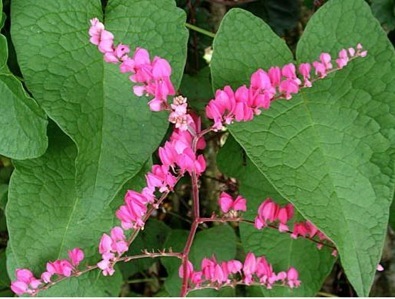 There are two common species of Coral Vine Antigonon leptopus (edible) and A. guatemalense (edibility unreported and not reported in Florida). The latter has larger leaves, hairy stems and short petioles, under two inches. A. leptopus has longer petioles, What is a petiole? Basically a leaf stem.
There are two common species of Coral Vine Antigonon leptopus (edible) and A. guatemalense (edibility unreported and not reported in Florida). The latter has larger leaves, hairy stems and short petioles, under two inches. A. leptopus has longer petioles, What is a petiole? Basically a leaf stem.
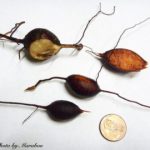
It can be a challenge to find coral vine roots. Photo by Marabou Thomas
Antigonon leptopus (long petioles) is completely edible, roots, leaves, seeds, and blossoms. In Thailand the blossoms and leaves are dredged in flour, fried, then served with noodles. The flowers also make their way into salads and omelettes. Natives in California roasted the seeds which pop. They can be ground into a meal for baking. Cooked roots are edible, however, I personally have found them difficult to harvest.
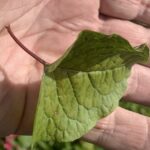
Antigonon leptopus has a long leaf stem. Photo by Green Deane
The vine can create a resistant mat that is hard to get through. A. guatemalense, short petioles, is not reported as edible, but as a member of the buckwheat family it might be. Coral vine is easy to find. I have seen it from Deland Fl to Sarasota. While it is easy to harvest leaves and blossom, the roots are more elusive and require some digging. A machine that scrapes the ground would be handy as the soil it is usually in is dry and hard. To read more about coral vine go here.

Mustard roots are edible. Photo by Green Deane
As mentioned in previous newsletters, wild mustard/radish is growing and blooming now. It likes cooler weather and in northern climes favors late spring, locally our early winter. (There’s been ice on my windshield three mornings in a row east of Tampa.) The entire plant is edible. I dry the blossoms and seeds for seasoning, boil the leaves as a green, and boil the roots, for a radish/turnip like vegetable. The roots have a tough outer jacket, that should be and can be peeled off, often in one piece. Then dice the inner root and cook. Wild Radishes tend to be serpentine rather than straight and tall like Wild Mustard. They also have lumpy seed pods, or, more lumpy than mustard seed pods. Usually you will find a stand of one or the other. I don’t recall finding both in the same patch. Blossom colors can range from yellow to white with streaks of purple. But the leaves always have the biggest lobe on the end farthest from the plant. Look for them in sunny areas with fertile soil. Not native they came from Eurasia in the 1700s. And note the seeds can remain viable in the soil for up to 60 years. To read more Wild Radish go here, and for Wild Mustard, here.
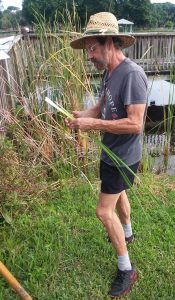
Teaching a foraging class in West Palm Beach
Foraging classes, now that the rash of storms has past, it is time to resume regular classes.
Dec 7th Eagle Lake Park: 1800 Keene Road, Largo, FL 33771. Meet at the pavilion near the dog park. 9 a.m. to noon.
Dec 8th Bayshore Live Oak Park: Bayshore Drive. Port Charlotte 9 a.m. to noon, meet at the parking lot at Bayshore Drive and Ganyard Street.
Dec 15th Mead Garden: 1500 S. Denning Dr., Winter Park, FL 32789. Meet at the bathrooms. 9 a.m. to noon.
For more information on these classes, to prepay or sign up go here. The cost is $30 per adult (the class is usually three hours long and examines five-dozen or so species.) If cost is a hardship email me at: GreenDeane@gmail.com.
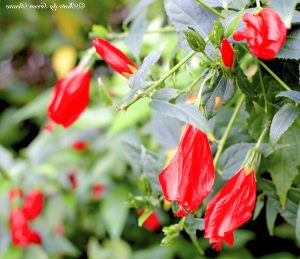
Malvaviscus pendiflorus. THese blossoms never open. Photo by Green Deane
The “Sleepy Hibiscus.” is happily blooming. It’s a fairly easy shrub to identify because the bright red blossoms that never unfurl. Also blossoming is the Bauhinia. It’s a tree that is both easy and challenging at the same time. The blossoms are edible, look nice in salads. Some of the species have edible seeds and some do not. (They are in the pea family and most pea trees — most not all — do not have edible seeds.) Sorting out which Bauhinia you have can be a challenge, nearly as bad as sorting out which Cereus you have. Like the Cereus cactus there are several man-made Bauhinia hybrids and perhaps even some fake botanical names. It can make species identification a real headache though as far as I know all Bauhinia blossoms are edible. Only “discovered” 111 years ago the blossom of the Bauhinia blakeana is the emblem of Hong Kong. You can read about the Bauhinia here.
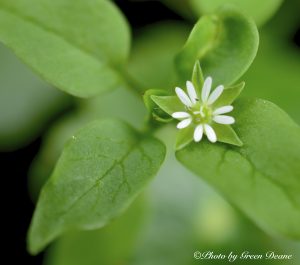 Real chickweed will soon arrive. If you want to sample it in a variety of ways you have a couple of months at best. I usually find chickweed locally between Christmas and Valentine’s Day. It can be found earlier and occasionally after Valentine’s Day. But those two holidays mark the practical beginning and end of the local chickweed season. It also doesn’t grow much farther south than central Florida. In northern climates Chickweed is a green of spring. It actually germinates under the snow so it can get a head start on other spring plants. Snow spits here every half century or so and the ground never freezes which is why we can forage 365 days a year. Chickweed is fairly easy to identify. Besides tasting like corn silk it has a stretchy inner core and one line of hair that runs along the stem switching sides at each pair of leaves. Don’t confuse Chickweed for a local cousin the edible, Drymaria cordata. To read more about chickweed click here. Also coming on strong is Pellitory. To read about Pellitory again click here.
Real chickweed will soon arrive. If you want to sample it in a variety of ways you have a couple of months at best. I usually find chickweed locally between Christmas and Valentine’s Day. It can be found earlier and occasionally after Valentine’s Day. But those two holidays mark the practical beginning and end of the local chickweed season. It also doesn’t grow much farther south than central Florida. In northern climates Chickweed is a green of spring. It actually germinates under the snow so it can get a head start on other spring plants. Snow spits here every half century or so and the ground never freezes which is why we can forage 365 days a year. Chickweed is fairly easy to identify. Besides tasting like corn silk it has a stretchy inner core and one line of hair that runs along the stem switching sides at each pair of leaves. Don’t confuse Chickweed for a local cousin the edible, Drymaria cordata. To read more about chickweed click here. Also coming on strong is Pellitory. To read about Pellitory again click here.

Green Deane Forum
Tired of Facebook and want to identify a plant? The Green Dean Forum is up and running again. Have you come to dislike Facebook, then join us on the forum. Perhaps you’re looking for a foraging reference? You might have a UFO, an Unidentified Flowering Object, you want identified. On the Green Deane Forum we — including Green Deane and others from around the world — chat about foraging all year. And it’s not just about warm-weather plants or just North American flora. Many nations share common weeds so there’s a lot to talk. There’s also more than weeds. The reference section has information for foraging around the world. There are also articles on food preservation, and forgotten skills from
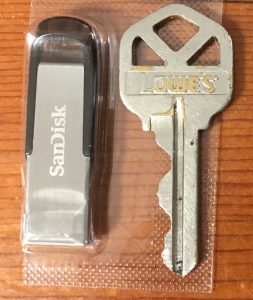
You get the USB, not the key.
172-video USB would be a good end of spring present and is now $99. My nine-DVD set of 135 videos has been phased out. The USB videos are the same videos I have on You Tube. Some people like to have their own copy. Most of the 172 USB videos have to be copied to your computer to play. If you want to order the USB go to the DVD/USB order button on the top right of this page. That will take you to an order form.
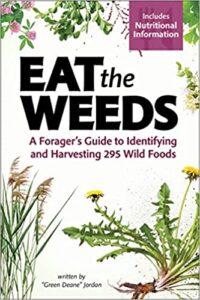
Now in second printing.
EAT THE WEEDS, the book, 274 plants, 367 pages, index, nutrition charts and color photos. It’s available in many locations including bookstores, Amazon. Most of the entries include a nutritional profile. It can also be ordered through AdventureKeen Publishing.
This is weekly newsletter #615. If you want to subscribe to this free newsletter you can find the sign-up form in the menu at the top of the page.
To donate to the Green Deane Newsletter click here.


The Bayshore Live Oak Park in Port Charlotte is fenced and off limits due to massive flooding from Helene and Milton. In that area all the houses have septic tanks, and the water level closed US 41. The trash, furniture, drywall, etc, closed several of streets we foraged on the previous trips when I’ve met with your trips. I would not feel safe even tasting various plants, but you do have to restart at some point.
Thanks for letting me know. It is kind of late to cancel, so I’ll just make do.
I would love you to have a class in Venice or Englewood…PLEASE and thank you!
I have classes at Port Charlotte, which has the same species one would find in Venice of Englewood. Indeed, I have a class there tomorrow 7 dec 2024.